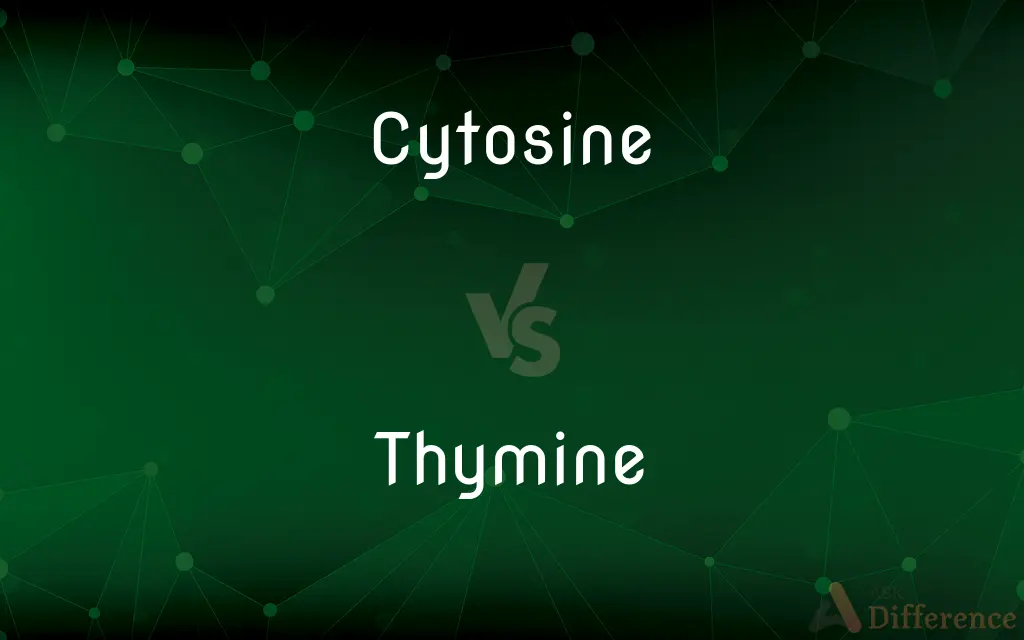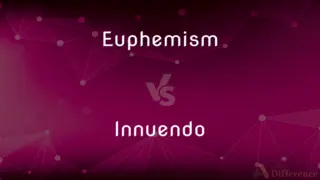Cytosine vs. Thymine — What's the Difference?
By Tayyaba Rehman — Updated on September 22, 2023
Cytosine is one of the four nitrogenous bases in DNA and RNA, while Thymine is a base found only in DNA.

Difference Between Cytosine and Thymine
Table of Contents
ADVERTISEMENT
Key Differences
Cytosine and Thymine are both vital components in the structure of DNA, serving as nitrogenous bases that pair with other bases to form the DNA double helix. Cytosine is a pyrimidine base, which means it has a single-ring structure. On the other hand, Thymine, also a pyrimidine base, shares this single-ring structure, but differs in its chemical composition and pairing partner.
Both Cytosine and Thymine play crucial roles in storing genetic information. Cytosine typically pairs with guanine, forming the C-G base pair, a connection facilitated by three hydrogen bonds. Thymine, in contrast, pairs with adenine in DNA, resulting in the T-A base pair, which is held together by two hydrogen bonds.
In the realm of molecular biology, the presence of Cytosine and Thymine is essential for the accurate replication of DNA. Mutations, or errors in pairing, involving these bases can lead to genetic disorders or diseases. For example, if Cytosine were mistakenly paired with Thymine, it could disrupt the genetic code.
A noteworthy distinction between Cytosine and Thymine is their presence across nucleic acids. While Cytosine is found in both DNA and RNA, Thymine is exclusive to DNA. In RNA, Thymine's counterpart is uracil, which pairs with adenine just as Thymine does in DNA.
Comparison Chart
Structure
Pyrimidine base (single-ring)
Pyrimidine base (single-ring)
ADVERTISEMENT
Pairing Partner in DNA
Guanine
Adenine
Number of Hydrogen Bonds
Forms three hydrogen bonds
Forms two hydrogen bonds
Presence
Found in both DNA and RNA
Found only in DNA
Chemical Composition
Contains an amino and keto group
Contains a methyl and keto group
Compare with Definitions
Cytosine
An essential part of the genetic code.
Mutations involving cytosine can lead to genetic disorders.
Thymine
A pyrimidine base found only in DNA.
Thymine pairs with adenine in the DNA ladder.
Cytosine
One of the four main bases in nucleic acids.
DNA contains adenine, thymine, guanine, and cytosine.
Thymine
One of the four primary bases in DNA.
Unlike RNA, DNA contains thymine instead of uracil.
Cytosine
A pyrimidine base found in DNA and RNA.
Cytosine pairs with guanine in the DNA structure.
Thymine
Forms two hydrogen bonds with its pairing partner.
The bond between thymine and adenine consists of two hydrogen bonds.
Cytosine
A component that forms three hydrogen bonds when pairing.
The strength of the bond between cytosine and guanine is due to three hydrogen bonds.
Thymine
Key to the accurate replication of genetic material.
Errors in pairing thymine can cause mutations in DNA replication.
Cytosine
Present in both types of nucleic acids.
Cytosine is found in both DNA and RNA sequences.
Thymine
Exclusive to DNA, not present in RNA.
In RNA, uracil takes the place of thymine.
Cytosine
Cytosine (; C) is one of the four main bases found in DNA and RNA, along with adenine, guanine, and thymine (uracil in RNA). It is a pyrimidine derivative, with a heterocyclic aromatic ring and two substituents attached (an amine group at position 4 and a keto group at position 2).
Thymine
Thymine (T, Thy) is one of the four nucleobases in the nucleic acid of DNA that are represented by the letters G–C–A–T. The others are adenine, guanine, and cytosine. Thymine is also known as 5-methyluracil, a pyrimidine nucleobase.
Cytosine
A pyrimidine base, C4H5N3O, that is the constituent of DNA and RNA involved in base-pairing with guanine.
Thymine
A pyrimidine base, C5H6N2O2, that is an essential constituent of DNA.
Cytosine
(biochemistry) A heterocyclic base, 4-aminopyrimidin-2(1H)-one, which pairs with guanine in DNA and RNA (by means of three hydrogen bonds).
Thymine
A heterocyclic base, 5-methylpyrimidine-2,4(1H,3H)-dione; it pairs with adenine in DNA.
Cytosine
A pyrimidine (C4H5N3O) which is one of the four major basic components of DNA and RNA in most organisms, forming glyosides with ribose and deoxyribose. It is the basic component of cytidine, deoxycytidine, cytosine, cytidine monophosphate, and derivatives of those compounds.
Thymine
A base found in DNA (but not in RNA) and derived from pyrimidine; pairs with adenine
Cytosine
A base found in DNA and RNA and derived from pyrimidine; pairs with guanine
Common Curiosities
What is Cytosine?
Cytosine is one of the four nitrogenous bases in DNA and RNA.
With which base does Cytosine pair in DNA?
Cytosine pairs with guanine in DNA.
Is Cytosine present in RNA?
Yes, Cytosine is found in both DNA and RNA.
Where is Thymine found?
Thymine is a nitrogenous base found only in DNA.
Why is the C-G pairing stronger than the T-A pairing?
The C-G pairing is stronger because it forms three hydrogen bonds, while the T-A pairing forms two.
In which nucleic acid is Thymine replaced by Uracil?
In RNA, Thymine is replaced by Uracil.
Are both Cytosine and Thymine pyrimidines?
Yes, both Cytosine and Thymine are pyrimidine bases.
Do mutations involving Thymine affect genetic codes?
Yes, mutations involving Thymine can disrupt the genetic code.
How many hydrogen bonds does Thymine form with its partner?
Thymine forms two hydrogen bonds with adenine.
What replaces Thymine in RNA?
In RNA, uracil replaces thymine.
How do Cytosine and Thymine differ in chemical structure?
Cytosine contains an amino and keto group, while Thymine has a methyl and keto group.
What happens if Cytosine is mistakenly paired with Thymine in DNA?
Such a pairing can lead to genetic mutations.
Can changes in Cytosine and Thymine lead to genetic disorders?
Yes, mutations involving these bases can result in genetic disorders or diseases.
Which base in DNA is exclusive to it and not found in RNA?
Thymine is exclusive to DNA and is not found in RNA.
Why are Cytosine and Thymine essential for life?
They play critical roles in storing and transmitting genetic information.
Share Your Discovery

Previous Comparison
Euphemism vs. Innuendo
Next Comparison
Blasphemous vs. SacrilegeAuthor Spotlight
Written by
Tayyaba RehmanTayyaba Rehman is a distinguished writer, currently serving as a primary contributor to askdifference.com. As a researcher in semantics and etymology, Tayyaba's passion for the complexity of languages and their distinctions has found a perfect home on the platform. Tayyaba delves into the intricacies of language, distinguishing between commonly confused words and phrases, thereby providing clarity for readers worldwide.














































